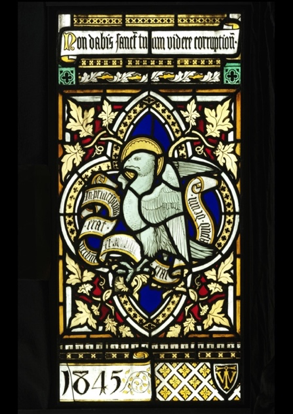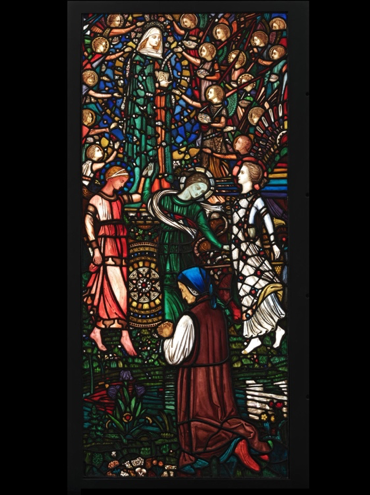This week we’re taking a closer look at the artform which was revered by late-Victorian artists. For many, it was one which allowed them to transfer their skills as fine artists to the decorative arts. De Morgan volunteer Sonja gives this fascinating insight into Pre-Rapahelite stained glass.
Stained glass enjoyed a revival in the Victorian period partly because many Victorian artists were disillusioned with industrialisation and mass production, and partly due ‘to the modern conservation movement, and the restoration of churches.’ (Brown, S. 2020). These Victorian artists began to look to the past for artistic inspiration and creative processes and were inspired by the Medieval period (around 1250 – 1500), a period they believed to be better, purer and simpler. This led to a new style known as the Gothic Revival. Many artists and architects researched the methods and techniques of medieval stained glass, about which there was limited knowledge. There was significant collaboration between scientists and artists to recreate medieval glass-making techniques, for example in making pot-metal glass, where metal oxides were mixed into molten glass in a pot. Copper oxides would produce shades of green, cobalt oxides produced a deep blue, gold produced for wine-red or violet coloured glass. This technique resulted in very rich colours, as can be seen in the blues and reds of Thomas Willement’s (1786 – 1871) work shown below, who was the official ‘Artist in Stained Glass’ to Queen Victoria at the beginning of the 19th century. It also meant there was less dependency on enamel paints to give colour to glass windows.

Panel, stained and painted glass, Thomas Willement, 1845, England. Museum no. C.151-1980. Given by Holy Trinity Church, Carlisle. © Victoria and Albert Museum, London
This Gothic Revival, church restoration and the introduction of stained glass in secular environments created a huge demand for stained glass windows, resulting in the establishment of many new stained-glass companies. For example, William Morris (1834 – 1896), an ardent critic of industrialisation, established the firm Morris, Marshall and Faulkner & Co. ’The Firm’ supplied stained glass windows for both religious and domestic buildings, and the stained glass from this company dominated the market for the last quarter of the century. Morris himself did not design the windows, but used either artists from the Pre-Raphaelite Brotherhood, such as Dante Gabriel Rossetti (1828 – 1882).
In around 1862, Rossetti, created the design below for Harden Hall in Bingley. There are 6 windows in total and they narrate the story of the legend of St George, and the events prior to and after his slaying of the dragon. Rossetti’s windows are vigorous and dramatic, much like his artworks, both in his use of colour and in his depictions of people. Another characteristic is ‘Rossetti’s distinctively strong female faces.’ (Beattie, S, 2014).

Panel, stained and painted glass, designed by Dante Gabriel Rossetti, made by Morris, Marshall, Faulkner & Co., 1862, England. Museum no. C.319-1927. © Victoria and Albert Museum, London
Typically, in the 19th century ‘artists did not execute the stained glass themselves: their designs were passed on to glass painters,’ (Beattie, S. 2014) and it was common practice for more than one person to work on the designs. The designs were added to company catalogues to be used again, and adapted to suit the location or the client’s preferences.
Stained glass window artists did not simply embody medieval techniques and artforms, but also used medieval literature for design inspiration. For example, Nathaniel Westlake’s (1883 – 1921), The Vision of Beatrice, c. 1863, which was designed specifically for the 1864 stained glass exhibition at the South Kensington Museum (now the V&A). This is taken from the Divine Comedy by Dante Aligheri, (c1265 1321) an Italian poet.

Vision of Beatrice, panel of coloured glass with painted details, Nathaniel Westlake, about 1863, England. Museum no. 780-1864. © Victoria and Albert Museum, London
Sources
Beattie, S., (2014) ‘Stained Glass on Paper: Morris & Co. and the Pre-Raphaelites’ at https://www.vam.ac.uk/blog/caring-for-our-collections/stained-glass-on-paper-morris-co-and-the-pre-raphaelites
Brown S., (2020) “Medieval Stained Glass and the Victorian Restorer”, 19: Interdisciplinary Studies in the Long Nineteenth Century 2020(30). doi: https://doi.org/10.16995/ntn.2901
https://thestainedglassmuseum.com/histsg.php
https://www.vam.ac.uk/articles/stained-glass-gothic-revival-and-beyond
http://www.victorianweb.org/art/stainedglass/pugin/clarke.html






